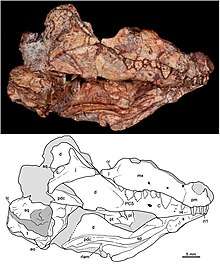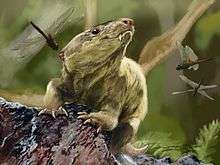Probainognathidae
Probainognathidae is an extinct family of carnivorous therapsids which lived during the Upper Triassic. It has three known members: Probainognathus from South America, the somewhat later Lepagia from Europe and Bonacynodon. The family was established by Romer in 1973. Its members were closely related to the even more exotically named Chiniquodontidae.
| Probainognathidae Temporal range: Early to Middle Triassic | |
|---|---|
 | |
| Bonacynodon skull | |
| Scientific classification | |
| Kingdom: | Animalia |
| Phylum: | Chordata |
| Clade: | Therapsida |
| Clade: | Cynodontia |
| Clade: | Probainognathia |
| Family: | †Probainognathidae Romer, 1973 |
| Genera | |
| |

Restoration of Bonacynodon
All of the genera were small animals. Probainognathus, known from a number of specimens, was about 10 cm in length and extremely mammal-like in terms of its anatomy. Remains of Lepagia are restricted to teeth. These most closely resemble the dentition of other carnivorous cynodonts of the Upper Triassic.
References
This article is issued from Wikipedia. The text is licensed under Creative Commons - Attribution - Sharealike. Additional terms may apply for the media files.